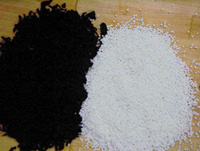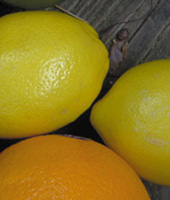The JVC GC QX5HD
A Lot More Than Meets The Eye
|
In the prosumer market, digital point-and-shoots have reached a sort of consensual plateau--where certain capabilities are standard and even expected. Just about all of them have an LCD preview screen and an optical viewfinder, instant playback and delayed shutoff, several resolution modes, an optical zoom, some kind of a variable built-in flash, video mode, and television review capabilities. For some time now, resolution in these cameras has been climbing steadily, and recently when I skimmed the Sunday paper there were several name-brand digital cameras touting 3-plus megapixel CCDs within the prosumer and even consumer price range. So what makes a digital point-and-shoot stand out in this crowd? Professional options, as well as manual capabilities to provide the photographer with the necessary tools to create quality imagery in their own signature style. Pro Features |
||||
Among the professional options, Pixel Shift mode allows you to double the resolution with two exposures. Available only for still photography, the camera shifts the CCD by one pixel for the second exposure, providing the photographer a whopping 6-plus megapixel file. Wide Range mode also uses two exposures, but this time the emphasis is on expanding the dynamic range. One exposure is adjusted for the bright portions of a scene, the second is adjusted to capture detail in the dark or shadow areas of a scene. The camera then combines the two exposures to create a file that has detail in both the highlight and shadow areas. To check out the dynamic range, I went to the local farmer's market in search of my favorite subject (food). To check out the highlight area a pile of tapioca pearls seemed like a good subject--but the dark shadow area end seemed a bit more of a challenge. While chocolate came to mind it was quickly nixed for fear that I would eventually be tempted to eat the props. I finally saw a bag of shredded wakame (seaweed), and knew I had found what I needed. No chance of temptation there at all. The dynamic range improved dramatically by taking two exposures--one for the highlights and one for the shadows, but we had to try it several times to make it work for us. |
||||
A third professional mode that improves quality beyond the normal range of a prosumer digital camera is the Noise Reduction mode. Again, like Wide Range and Pixel Shift for still photography, it requires more than one (several in this case) exposures. Addressing an important concern in the digital photography environment, this option is designed to lessen noise problems by capturing a large amount of information from which it extracts signal components and eliminates the noise that plagues some digital cameras in this price range. We used this option to capture several pieces of fruit and found that improvement was minimal until we enlarged it--then the improvements became apparent, specifically in the shadow areas. This can prove to be a good option when shooting still life scenarios where noise may prove to be a problem. For anyone needing to scan film, the QX5 comes with a film-copying adapter that allows you to "scan" 35mm processed negatives and unmounted positives. We didn't have any unmounted transparency film so we opted to check it out using negative film. With the camera set on Manual, we selected the Film mode and then selected the appropriate film copy settings. We used a light table for backlighting and the results were interesting albeit not accurate. Carla anxiously waiting for the bar to open with the curlers still in her hair turned a little off-color, although the red neon sign stayed true amidst the blue-hued scene. Funny thing is, I liked this rendition better than the original, but we do not recommend you use the QX5 as a scanner. We did not have the opportunity to check out the Collage option, which according to JVC allows the user to place a subject in prerecorded background (both images must be taken with the QX5). It's simply a matter of selecting the Collage mode, then photographing the background, and then photographing the subject in front of a white background. The camera does the rest, however, the subject cannot wear white clothing and flash is not available for this option. |
||||
A Versatile And Responsive
Point-And-Shoot The QX5 offers excellent macro shooting capabilities, with close focus from just 2-50cm. The 2.3x optical zoom (37-86mm equivalent) is a good range for many applications. And we'd like to note that the 2.3x zoom is optical (not digital) providing full resolution along the zoom range--unlike digital zooms that merely enlarge and crop the center of the frame, diminishing image quality in the transition. On single shot the QX5 offers three compression options (standard, fine, no compression), and three resolution options (2032x1536, 1024x768, and 640x480) that can be easily adjusted by pressing the Display button on the back of the camera while it is set on A (Automatic). JVC refers to these settings as frame size rather than resolution, which may be a bit confusing if you are used to other digital point-and-shoots. Playback is simple and immediate on the 2" polysilicon TFT 200,000 pixel LCD screen on the back of the camera. There are several Display modes available, including full screen and a six-indexed picture screen. Brightness of the LCD screen is adjustable and images can be protected from accidental erasure. JVC also provides the GV-SP2, an optional printer that allows the user to print directly from the QX5 via an optional printer cable. Via the camera's menu you can print both bordered and borderless prints, multiple copies, as well as thumbnail prints and your own photo stickers. We found the JVC GC-QX5HD to be a versatile point-and-shoot with some very impressive professional options. For anyone needing a responsive little digital camera with high-resolution capabilities the QX5 is worth looking into, but make sure you get an extra battery if you are planning on using it on location. The MSRP is $1299.95, and you can check it out at: www.jvc.com |
||||
Technical Specifications |
- Log in or register to post comments








































